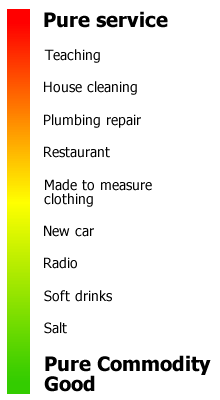Goods and services
Goods are items that are usually (but not always) tangible, such as pens, salt, apples, and hats. Services are activities provided by other people, who include doctors, lawn care workers, dentists, barbers, waiters, or online servers, a book, a digital videogame or a digital movie. Taken together, it is the production, distribution, and consumption of goods and services which underpins all economic activity and trade. According to economic theory, consumption of goods and services is assumed to provide utility (satisfaction) to the consumer or end-user, although businesses also consume goods and services in the course of producing other goods and services (see Distribution (marketing)#Channels_and_intermediaries).
.jpg)

| Part of a series on |
| Capitalism |
|---|
|
Concepts
|
|
Economic systems
|
|
Economic theories
|
|
Origins
|
|
Development
|
|
Related topics
|
|
Ideologies
|
|
History
Physiocratic economists categorized production into productive labour and unproductive labour. Adam Smith expanded this thought by arguing that any economic activities directly related on material products (goods) were productive, and those activities which involved non-material production (services) were unproductive. This emphasis on material production was adapted by David Ricardo, Thomas Robert Malthus and John Stuart Mill, and influenced later Marxian economics. Other, mainly Italian, 18th century economists maintained that all desired goods and services were productive.[1]
Service-goods continuum

The division of consumables into services is a simplification: these are not discrete categories. Most business theorists see a continuum with pure service at one endpoint and pure tangible commodity goods at the other. Most products fall between these two extremes. For example, a restaurant provides a physical good (prepared food), but also provides services in the form of ambience, the setting and clearing of the table, etc. Although some utilities, such as electricity and communications service providers, exclusively provide services, other utilities deliver physical goods, such as water utilities. For public sector contracting purposes, electricity supply is defined among goods rather than services in the European Union,[2] whereas under United States federal procurement regulations it is treated as a service.[3]
Goods are normally structural and can be transferred in an instant while services are delivered over a period of time. Goods can be returned while a service once delivered cannot.[4] Goods are not always tangible and may be virtual e.g. a book may be paper or electronic.
Marketing theory makes use of the service-goods continuum as an important concept[5] which 'enables marketers to see the relative goods/services composition of total products'.[6]
In a narrower sense, service refers to quality of customer service: the measured appropriateness of assistance and support provided to a customer. This particular usage occurs frequently in retailing.[7]
In international law
Distinctions are made between goods and services in the context of international trade liberalization. For example, the World Trade Organization's General Agreement on Tariffs and Trade (GATT) covers international trade in goods[8] and the General Agreement on Trade in Services (GATS) covers the services sector.[9]
See also
- Commodity (Marxism)
- Fast-moving consumer goods
- Goods and services tax
- List of countries by GDP sector composition
- Three-sector theory
- Tertiary sector of the economy
References
- Martin Shubik (23 June 2014). Proceedings of the Conference Accounting and Economics: In Honour of the 500th Anniversary of the Publication of Luca Pacioli's Summa de Arithmetica, Geometria, Proportioni et Propotionalita, Siena, 18-19 November 1992. Taylor & Francis. pp. 236–237. ISBN 978-1-135-60837-8.
- UK Legislation. "The Public Contracts Regulations 2006". Regulation 2(1) s.v. "goods". Retrieved 25 June 2015
- Federal Acquisition Regulation, Subpart 41.2 — Acquiring Utility Services, accessed 12 May 2018
- "Difference Between Goods and Services: Visual Guide". Inevitable Steps. 3 March 2016. Retrieved 3 March 2016.
- Indiaclass, "Goods Service Continuum". Accessed 25 June 2015. Archived 25 April 2015 at the Wayback Machine
- Bachelors of Management Students Portal (BMS.co.in). "Explain the Goods-Service Continuum". Accessed 25 June 2015
- Mattsson, Katriina (2009). "Customer satisfaction in the retail market" (PDF). Theseus. pp. 15–16. Retrieved 18 November 2015.
- WTO, GATT and the Goods Council accessed 17 November 2015
- WTO, Services trade, accessed 17 November 2015
Further reading
- Hendrickson, C.T.; Lave, L.B.; Matthews, H.S. (2010). Environmental Life Cycle Assessment of Goods and Services: An Input-Output Approach. Taylor & Francis. ISBN 978-1-136-52549-0. 274 pages.
- Murley, L.; Wilson, A. (2011). The Distribution of Goods and Services. Dollars and sense: a guide to financial literacy. Rosen Central. ISBN 978-1-4488-4710-5. 64 pages.
- Smith, Adam. The Wealth of Nations at Project Gutenberg
External links
| Library resources |
| By Goods and services |
|---|